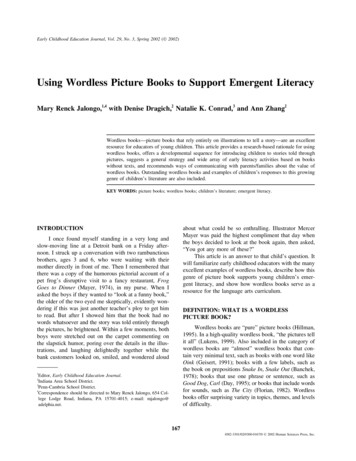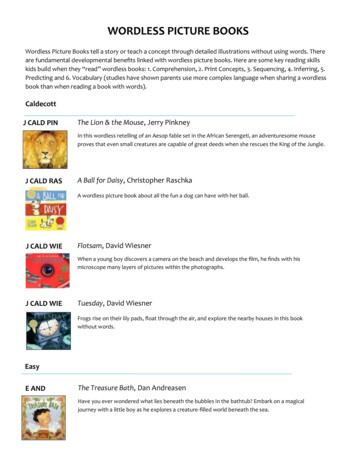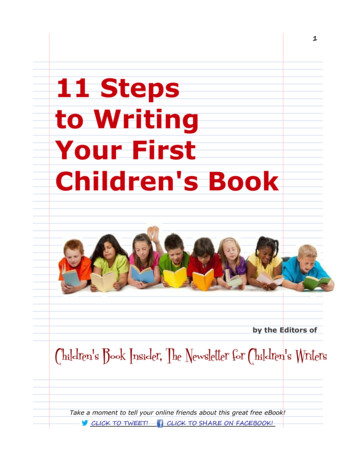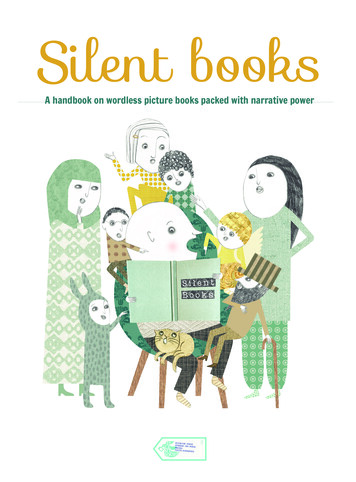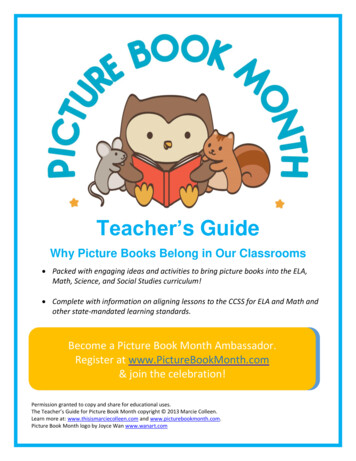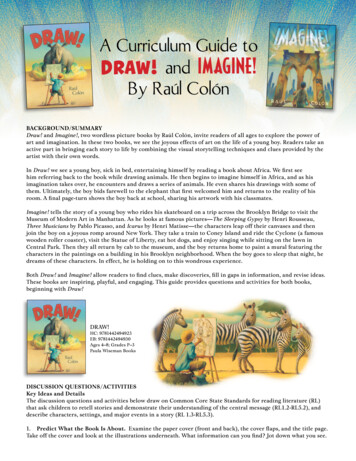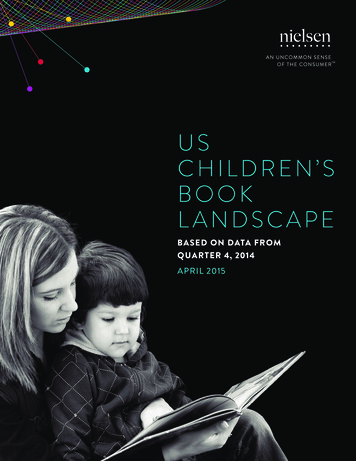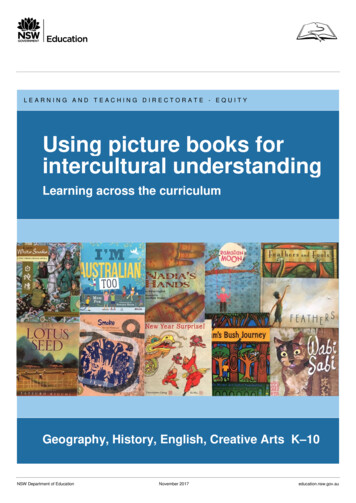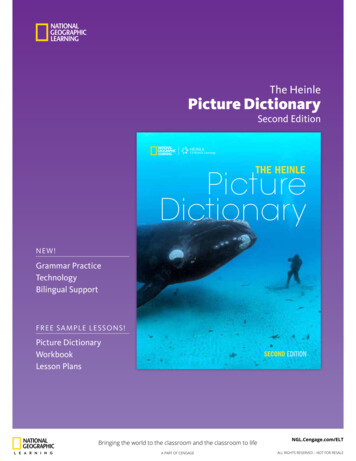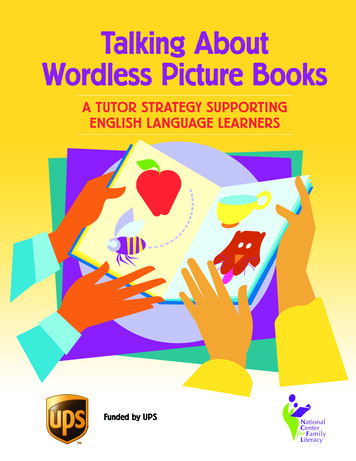
Transcription
Talking AboutWordless Picture BooksA TUTOR STRATEGY SUPPORTINGENGLISH LANGUAGE LEARNERSFunded by UPS
Talking AboutWordlessPicture BooksA Tutor StrategySupportingEnglish Language Learners1st EditionFunded by UPS
AcknowledgmentsPlanning for Volunteers in Literacy: A Guidebook and Talking About Wordless Picture Books: A Tutor StrategySupporting English Language Learners are products of a project developed by the National Center for FamilyLiteracy (NCFL) and funded by UPS. Both texts are included in the toolkit Engaging Family LiteracyVolunteers, Tutors and Learners along with a CD of customizable forms and templates.NCFL gratefully acknowledges the work of many individuals who contributed to this project:Planning for Volunteers in Literacy: A Guidebook was written by Noemi Aguilar, Susan Lythgoe, SusanMcShane, Jane Mencer, Karen Smith, Amy Wilson and Johnnie (Shani) L. Brown-Falu.Talking About Wordless Picture Books: A Tutor Strategy Supporting English Language Learners was written byJanet M. Fulton.Guidance for the development of these materials was provided by Becky King, NCFL, and Barbara Van Hornand Maria Leonor L. Marvin, Goodling Institute for Research in Family Literacy, Pennsylvania StateUniversity.Editorial, design and support services were provided by Gail J. Price, Jennifer McMaster, Akeel Zaheer, andKathy Zandona.Our sincere thanks to NCFL’s partners in the UPS Family Literacy Volunteer Academy:Chippewa Valley-Literacy Volunteers (Eau Claire, Wisconsin), The Learning Source for Adults and Families(Lakewood, Colorado), Pima College Adult Education (Tucson, Arizona), and Rochester City School District(Rochester, New York) for their participation in piloting materials, evaluation and ongoing input andencouragement.We are grateful for the suggestions of the program coordinators who piloted the guidebook at the followingsites: Sandy Bamford (Doughtery County Even Start, Albany, Georgia), Cindy Dumas (Family LearningCenter, Rochester, NY), Johanna Downey (Sierra Valley Even Start Family Literacy Program, Portola, CA),Mary English (Early Years Even Start Program, Jacksonville, IL), Colleen Gray (The Literacy Project, Minturn,CO), Mary Green (Sault Tribe of Chippewa Head Start, Sault Ste. Marie, MI), Valerie Harrison (RichmondEven Start, Richmond, VA), Jennifer Hume (Allen ISD Family Literacy, Allen, TX), Jennifer Jones (Alliancefor Families with Children, Plantation, FL), Stephanie Koch (Literacy Volunteers-Chippewa Valley, Eau Claire,WI), Martha Lane (United Methodist Cooperative Ministries, Clearwater, FL), Ellen Lauricella (LiteracyVolunteers of Leon County, Tallahassee, FL), Teri Locke (Jefferson County Even Start, Madison, IN), SusanLythgoe (The Learning Source for Adults and Families, Lakewood, CO), Kay McKinley (Scott County PublicSchools Community Education, Georgetown, KY), Lorna Milman (The Village Ready for School Center,Canoga Park, CA), Kathy Nelson (Beaufort County Even Start, Washington, NC), Jessica Noon (ESL TutorProgram, Arlington, VA), Jane Rockwell (Literacy Volunteers-Chippewa Valley, Eau Claire, WI), MarianneSanders (Grundy County Even Start, Tracy City, TN), Linda Shaddix (RAFT, Orlando, FL), Dee Siemianowski(The Immokalee Foundation Jump Start Program, Naples, FL), Susan Sieverman (Frederick Douglass FamilyLiteracy, New York, NY), Karen Smith (Pima College Adult Education, Tucson, AZ), Johanna Stowe (EvenStart Family Literacy Program, Hugoton, KS), Alexa Titus (Literacy Partners, Inc., New York, NY), FrancesVargas (GROWS Family Literacy, Apopka, FL), Howard Veeder (YMCA Family Resource Center, BatonRouge, LA), Mary Wallace (Branch ISD, Coldwater, MI), Amy Wilson (Goodling Institute for Research inFamily Literacy, State College, PA), Leandra Woods (Eastside Family Literacy Program, Los Angeles, CA)Our sincere thanks to the members of the UPS Family Literacy Volunteer Academy focus group for theirinitial guidance and input: Stephanie Koch, Teri Locke, Susan Lythgoe, Donna Phillips, Jane Rockwell, KarenSmith, and Amy Wilson.Special thanks to Sharon Darling, President and Founder of the National Center for Family Literacy, for hervision and guidance on this project.This publication was made possible by the generous support of UPS 2006 by the National Center for Family Literacy
Table of ContentsIntroduction . . . . . . . . . . . . . . . . . . . . . . . . . . . . . . . . . . . . . . . . . . . . . . . . . . . . . . . . . .1Getting Started . . . . . . . . . . . . . . . . . . . . . . . . . . . . . . . . . . . . . . . . . . . . . . . . . . . . . . .2Topic 1 – Introduction: Personal Experience StoriesSession 1 . . . . . . . . . . . . . . . . . . . . . . . . . . . . . . . . . . . . . . . . . . . . . . . . . . . . . .9Parent Handout — Storyboard Graphic Organizer . . . . . . . . . . . . . . . . . . .13Session 2 . . . . . . . . . . . . . . . . . . . . . . . . . . . . . . . . . . . . . . . . . . . . . . . . . . . . .14Topic 2 – Single Picture StoriesSession 1 . . . . . . . . . . . . . . . . . . . . . . . . . . . . . . . . . . . . . . . . . . . . . . . . . . . . .18Parent Handout — Tell a Story . . . . . . . . . . . . . . . . . . . . . . . . . . . . . . . . . . .22Session 2 . . . . . . . . . . . . . . . . . . . . . . . . . . . . . . . . . . . . . . . . . . . . . . . . . . . . .23Topic 3 – Wordless Picture Book StoriesSession 1 . . . . . . . . . . . . . . . . . . . . . . . . . . . . . . . . . . . . . . . . . . . . . . . . . . . . .27Session 2 . . . . . . . . . . . . . . . . . . . . . . . . . . . . . . . . . . . . . . . . . . . . . . . . . . . . .31Topic 4 – Story WebsSession 1 . . . . . . . . . . . . . . . . . . . . . . . . . . . . . . . . . . . . . . . . . . . . . . . . . . . . .35Parent Handout — Story Web Graphic Organizer . . . . . . . . . . . . . . . . . . . .39Session 2 . . . . . . . . . . . . . . . . . . . . . . . . . . . . . . . . . . . . . . . . . . . . . . . . . . . . .40Topic 5 – Event MapsSession 1 . . . . . . . . . . . . . . . . . . . . . . . . . . . . . . . . . . . . . . . . . . . . . . . . . . . . .44Parent Handout — Event Map Graphic Organizer . . . . . . . . . . . . . . . . . . .48Session 2 . . . . . . . . . . . . . . . . . . . . . . . . . . . . . . . . . . . . . . . . . . . . . . . . . . . . .49Topic 6 – Star StoriesSession 1 . . . . . . . . . . . . . . . . . . . . . . . . . . . . . . . . . . . . . . . . . . . . . . . . . . . . .53Parent Handout — Star Story Graphic Organizer . . . . . . . . . . . . . . . . . . . .58Session 2 . . . . . . . . . . . . . . . . . . . . . . . . . . . . . . . . . . . . . . . . . . . . . . . . . . . . .59Topic 7 – Concept Picture BooksSession 1 . . . . . . . . . . . . . . . . . . . . . . . . . . . . . . . . . . . . . . . . . . . . . . . . . . . . .64Session 2 . . . . . . . . . . . . . . . . . . . . . . . . . . . . . . . . . . . . . . . . . . . . . . . . . . . . .68
Topic 8 – Story CharactersSession 1 . . . . . . . . . . . . . . . . . . . . . . . . . . . . . . . . . . . . . . . . . . . . . . . . . . . . .72Session 2 . . . . . . . . . . . . . . . . . . . . . . . . . . . . . . . . . . . . . . . . . . . . . . . . . . . . .76Topic 9 – Building MeaningSession 1 . . . . . . . . . . . . . . . . . . . . . . . . . . . . . . . . . . . . . . . . . . . . . . . . . . . . .80Session 2 . . . . . . . . . . . . . . . . . . . . . . . . . . . . . . . . . . . . . . . . . . . . . . . . . . . . .85Topic 10 – Review and Celebrate: My StorySession 1 . . . . . . . . . . . . . . . . . . . . . . . . . . . . . . . . . . . . . . . . . . . . . . . . . . . . .89Session 2 . . . . . . . . . . . . . . . . . . . . . . . . . . . . . . . . . . . . . . . . . . . . . . . . . . . . .92Appendix . . . . . . . . . . . . . . . . . . . . . . . . . . . . . . . . . . . . . . . . . . . . . . . . . . . . . . . . . . .95Parent Success StoryParent Handout — Vocabulary and Knowledge BuildingParent Handout — Picture Books for PreschoolersTutor Handout — Tutor ReflectionCertificate of ParticipationAnnotated Wordless Picture Books ListWorking with English Language LearnersNational Reporting System ESL Functioning Level Descriptors (Summary)Resources for TutorsReferences and Further Reading
IntroductionTalking About Wordless Picture Books: A Tutor Strategy Supporting EnglishLanguage Learners is designed to support tutors who are working with lowintermediate English language learner (ELL) parents in family literacyprograms. It provides instructional activities with guidance that describes specificlanguage learning strategies to help ELL parents build and practice Englishconversational skills.Tutors model conversational skills by using questioning strategies. Open-endedquestions and prompts are created from “wh” questions (who, what, where, whenand why) to provide the stimulus for extending conversations between parentsand tutors. Parents are then encouraged to apply the strategies they learn towordless picture books they will share with their children. This creates a mutuallybeneficial situation for parents as they practice their English speaking skills whilelearning strategies that can be used to support their children’s language andliteracy development.Parents are encouraged to use the strategies they learn in tutoring sessions withtheir children using their home language. By providing young children with afirm foundation in their home language, parents give them a basis for learning toread and for learning other languages, including English. Some parents may wantto use these strategies in English as well, to work on their own skills and tosupport their older children’s school readiness and success.Tutor Tip:This program and its supporting materials were created for parents who arelearning English at the Low Intermediate level and who have preschoolchildren. You will need to adapt the materials for parents at other ESL levelsand for children at different ages.1Talking About Wordless Picture Books
Getting StartedHow Do I Use These Materials?If you are reading this, you probably have agreed to do some tutoring withEnglish language learner parents in a family literacy program. Great! Thematerials included here have been designed to guide you through each session.This program has been created for parents who are learning English skills at theLow Intermediate level. Parents at this level have some control of basic grammarand can: Understand simple phrases they have learned. Understand new phrases containing familiar vocabulary spoken slowlywith frequent repetition. Ask and respond to questions using the phrases they know. Express basic survival needs. Participate in routine social conversation (with some challenges).In this program, there are ten topic areas with follow-up practice (application)activities. Each topic is divided into two sessions and includes instructionalactivities that should be presented in the sequence in which they appear here.Each facilitation plan guides you through the learning and skill developmentactivities you will share with parents.These tutoring sessions will work best with a parent one-on-one (although theinstructions will refer to “parents” throughout). Small group tutoring sessionsmay require additional preparation to support parents with different languagelearning needs and levels. Lessons are designed so that you will demonstrate, ormodel, learning activities along with questioning strategies parents can use inconversational settings. These language learning activities are used to shareconversations about wordless picture books. Parents then have an opportunity topractice the strategy you modeled in the tutoring sessions through conversations,reading and writing. They then are encouraged to apply this same learningactivity with their child at home using their home language.2Getting Started
How Does It Work?Each tutoring session is based on developing and sharing a conversation aroundwordless picture books and connecting that conversation to parents’ personalexperiences. Parents are encouraged to tell stories through pictures as a means ofdeveloping vocabulary and to build English language skills. Parents will then beable to use these storytelling (conversation) strategies to support their child’slanguage and literacy development using wordless picture books.A graphic organizer—an instructional tool used to illustrate a learner’s knowledgeabout a particular topic or piece of text—often supports the conversation. Whengraphic organizers are called for, they are provided in the session material. Askabout the program’s policies for making copies for students. You may want toenlarge the graphic organizers so students have more room to write or draw.Each topic is delivered in two sessions:Session 1—Focuses on the story line. Help parents determine the story thepictures convey by asking questions, such as: What is the title of the story or book? Does it give you a clue to what thestory might be about? (Ask before reading) How do the pictures tell the story? What is the theme or main idea of the story? How does the story start (beginning)? What happens next (middle)? Howdoes the story end? Did the title tell you what the story or book was about? (Ask after reading)Session 2—Focuses on drawing out conversations around the meaning of thestory. This session encourages parents to look for the meaning of the story as theyconnect it to their own life experiences. Conversations support the developmentand use of new vocabulary words, the development of language learning skills,grammar, pronunciation, word building and other important parts of languagedevelopment. Encourage parents to: Talk about and build on the story idea. Explore the pictures to find clues about each part of the story. Use vocabulary based on what the story is about and connect new wordsto their life experiences. Connect the main idea or theme of the story to their prior knowledge—For example, how does this remind you of other things you and yourfamily have experienced? Does your family have a daily routine like thefamily in the story?3Getting Started
Why Focus on Storytelling?Using wordless picture books allows those who are learning a new language toexpress themselves through the pictures of a book without having to read words.Storytelling is something we all can do. Stories and storytelling have a long, richhistory. We told stories and shared experiences around community campfires ortables as a way to keep culture thriving, learn lessons about life and to knowabout worlds outside our own. Stories have the ability to entertain, tantalize,teach, transfer cultural knowledge and transform the way we see ourselves.Everyone has a story to share.Storytelling is also a wonderful way to link literacy development and languagelearning. Through stories, parents and children hear a new language spoken andbecome acquainted with the sounds and rhythms of language patterns. Together,through stories, parents and children build vocabulary knowledge in their newlanguage. Storytelling can elicit lively conversations, develop verbal language skillsand provide an opportunity to express personal thoughts and feelings. And asalways, storytelling remains an important avenue forexploring, evaluating, re-enforcing and passing on wisdom,beliefs and community values.What Are Wordless Picture Books?Wordless picture books are just what they sound like—bookswithout words (or sometimes with minimal words) that tell astory through pictures. Because they don’t rely on words toexpress their stories, wordless picture books can be used todevelop important literacy skills, such as: Detecting sequence Identifying details Noting cause and effect relationships Making judgments Determining main ideas Making inferencesSharing wordless picture books with parents who are English language learners(ELLs) creates exciting language learning conversations that will help themdevelop English speaking skills. Pictures act as a stimulus for buildingconversations. Finding the story through the pictures involves both listening andspeaking skills. It also gives parents the opportunity to express their personalthoughts and feelings and to use their imaginations. Parents can consider newideas and life scenarios different from their own. This may involve comparing andcontrasting new cultural values or systems with parents’ home culture.4Getting Started
Remember, ideas about a story may differ based on parents’ backgrounds andprevious experiences, so be patient and flexible.Before starting this program, review the annotated list of wordless picture booksin the Appendix. Talk with your program supervisor or volunteer coordinatorabout how you can access books to share with parents. Some programs haveformed partnerships with philanthropic organizations to purchase books forstudents, purchase books at a discount from library sales, or make arrangementsthrough a school library to allow parents to check out books. Ideally, you will beable to provide books that parents can borrow to use with their children at home.You also may want to suggest that parents get a public library card if they don’talready have one.Note: Most wordless picture books are designed to tell a story. But there are alsoconcept picture books, which focus on a specific topic such as the alphabet,numbers or colors. Both types of wordless picture books are used in this program.What Are Some Strategies That Can Reinforce and Extend Parents’ Learning?Actively involving parents can reinforce and extend the messages you are teaching.Following are some suggestions for ways to engage parents in learning. Journals—Encourage parents to write ideas about a story in a notebook,including the story name and the author. To start, you may need to write outideas generated by parents so that they can copy them into their notebooks.Try to use the vocabulary you have created from the story. Ask parents to readthe ideas together. Go back occasionally to read journal entries. Dialogue Bubbles—Invite parents to record on post-it notes what charactersin the story may be thinking, feeling and saying. Help parents write theirideas. Then parents can share what they have written with each other. Magazine Ads—Use advertisements as examples of one-picture frames thatconvey a message so you will buy a product. Look for advertisements that usea minimum of words but still depict a clear message. This can be a fun groupproject. Story Cards—Reproduce a few pictures from the story that are important tothe development of the main idea or theme. Make sure you have picturesfrom the beginning, middle and end of the story. Then ask parents to put thepictures in order (sequence). Discuss what clues they used to determine order.5Getting Started
Dramatization—Use props (toys, puppets, objects) to dramatize a story byacting it out. Invent dialogue for the characters to extend vocabulary practiceas well as increase parents’ understanding of the story. If working with a smallgroup of parents, have them work in pairs and then present theirdramatization to the class. Parents can use dramatization as a way to helptheir children build vocabulary and language skills. Picture Clues—Help parents discover what the pictures reveal about thestory. For example, in the book Do You Want to Be My Friend?, differentanimals appear on each page. On the bottom of each page of the book, thereis a green line. At the end, you find out the green line is a snake. Use questionsand prompts to help parents look for and understand picture clues, such as: ––– Is there anything you see that appears repeatedly as we look at this story?Why do you think the author put it there?Where do you think that picture is leading us?How does the picture help us know what will happen next?Using Questions to Develop the Story—Asking parents open-endedquestions (those that require more than a yes or no answer) is a good way toengage them in the story, and a great strategy they in turn can use with theirchildren. For example, you can ask:– What does the first page tell you about the story?– What is happening in this picture?– If this book had words, what would they be?– How do you think the people in this picture feel?– This is the last picture in the story. What do you think happens next?Time to Get StartedCongratulations! You’ve decided to embark on an exciting, interesting andmeaningful journey as you work with English language learning parents. Plan onbecoming a reliable conversation partner and developing meaningfulconversations as you help parents improve their English skills and support theirchildren’s learning. Remember, just like the parents you’ll be working with, youaren’t expected to do it alone. The staff and other volunteers in your program areat the ready to lend their experience and expertise.6Getting Started
Tutor Session TopicsEach topic contains two different tutoring sessions that build on one another.Session 1—Focuses on the story line. This session helps parents determine thestory the pictures convey. An important question for this session is, “What is goingon here?”Session 2—Focuses on drawing out conversations around the meaning of thestory. This session encourages parents to look for the meaning of the story as theyconnect it to their own life experiences. An important question for this session is,“What do you see?” Conversations support the development and use of newvocabulary words, the development of language learning skills, grammar,pronunciation, word building and other important parts of language development.TopicsDialogue & Conversation SupportsTopic 1 – Introduction:Personal Experience StoriesStorytelling – Storyboard Graphic OrganizerTopic 2 – Single Picture StoriesQuestions with Single PicturesTopic 3 – Wordless Picture BookStoriesQuestions with Wordless Picture BooksTopic 4 – Story WebsStory Web Graphic OrganizerTopic 5 – Event MapsEvent Map Graphic OrganizerTopic 6 – Star StoriesStar Story Graphic OrganizerTopic 7 – Concept Picture BooksQuestion Focus – Concept & Alphabet BooksTopic 8 – Story CharactersDialogue BoxesTopic 9 – Building meaningQuestion with a Graphic OrganizerTopic 10 – Review andCelebrate: My StoryParent Success StoriesProgram Certificates7Getting Started
TOPIC 1:Personal Experience StoriesSession 1Tutor Tip:Pictures act as the stimulus for building your language learning conversations.You and ELL parents will bring your own meaning to the pictures you read. Usethe wordless picture books to provide important and safe avenues for ELLparents to consider new ideas and different life scenarios.Cultural sensitivity is important. While wordless picture books provide anopportunity to explore cultural values and belief systems, they also may shownew or different experiences. Help parents recognize and discuss the similaritiesand differences to their own life experiences.Materials/ResourcesRead through the materials for both sessions in this topic before conducting thefirst session. Parent Success Story—there is an example in the Appendix, or use one ofyour own Storyboard Graphic Organizer—the template follows Topic 1, Session 1 A Storyboard you have created in advance for the parent success storyWelcome (2-5 minutes)Build a comfortable relationship with parents so that they feel safe in trying newthings. At the beginning of the session, ask about their children, their home lives,a new job, their goals and their interests. Always look for ways to create a fun andmeaningful learning atmosphere.Topic Introduction (2-5 minutes)Share the goals of this topic with parents: To experience storytelling in English and having conversations aboutstories To make personal connections to stories we read or hear To build English language skills through conversations9Topic 1: Personal Experience Stories Session 1
Objective for Session 1: To share a story about a personal experience and to talkabout and practice finding the main parts of the story—the beginning, middleand end.Opening Activity (5-10 minutes)1. Select a parent success story to share with parents and create a StoryboardGraphic Organizer for it (provided as a template at the end of this session).Choose a story you think will inspire, encourage or motivate parents. There isa parent success story in the Appendix, or you may choose a story from afavorite book or video, or a story you know personally (be sure not to share alocal student’s identity, though, unless you have permission to do so). Forother student success stories, also visit Verizon Literacy Campus atwww.literacycampus.org.2. Share with parents the story you’ve selected for this session. Model the use ofthe Storyboard you created to help you remember the details of the story.3. Ask parents what they liked about the story.4. Talk about the ways children enjoy stories, and also how adults share storiesfor entertainment, to remember or comment on important events, and toexpress their thoughts and feelings.Central Ideas and Practice (20-30 minutes)1. Share with parents the Storyboard Graphic Organizer you used to tell yourstory. Talk about how it helped you remember and tell the story sequence stepby step, from the beginning through the middle and to the end of the story.2. Point out and discuss any questions you used to help you remember and tellthe story, especially “wh” questions like who, what, where, when, why andhow. Show and discuss where these questions are answered on yourStoryboard.3. Retell your story and ask parents to listen carefully. Invite them to make theirown Storyboard, drawing pictures to help them remember what happens inthe story.4. Ask parents to think about the way the story begins, what happens in themiddle, and how it ends. Help them label the blocks in their Storyboard thatrepresent these three parts.5. Next, encourage parents to give the story a title and write it in the box at thetop of their Storyboard.6. Finally, invite parents to retell the story in their own words, using the picturesthey drew as prompts.10Topic 1: Personal Experience Stories Session 1
Tutor Tip:Save the Storyboard you created and the Storyboards that parents create in thissession. You will refer to them in the final Topic (10) tutoring session.Evaluation (5-10 minutes)Check to make sure parents understand the concepts you practiced during thesession (i.e., that stories have a beginning, middle and end). Assess theirunderstanding by asking parents to help you identify the beginning, middle andend of the opening activity story using the Storyboard Graphic Organizer youinitially created.Do parents need more practice or support? If yes, provide additional practice ordiscussion before going on to the session application and closure.Application – Practice these skills and strategies with your child (10-15 minutes)1. Provide parents with a blank Storyboard Graphic Organizer to take home.Encourage them to create, with their child, a Storyboard that describes one oftheir family routines. Suggest some of the following routines, and ask parentsif they have other suggestions. Putting your child to bed Getting ready for mealtime Getting ready in the morning Giving your child a bath2. Let parents know that every box of the Storyboard does not need to befilled—only the number of boxes needed to tell the story.3. Also let parents know they should tell their stories with their children usingtheir home language. Share with parents that by providing young childrenwith a firm foundation in their home language, parents give them a basis forlearning to read and for learning other languages, including English.4. Encourage parents to look at the pictures and review the story a few times,alone and with their child, before they return for the next session.5. Encourage parents to use “wh” questions and the conversation strategies theypracticed during the tutoring session. Encourage parents to talk with theirchild about the beginning, middle and end of their family routine story, andto give their story a title.6. Answer any questions parents have about the assignment before they leave.11Topic 1: Personal Experience Stories Session 1
Closure (5-10 minutes)Review the main points of the session. Telling stories provides an opportunity to develop conversations and topractice new language skills. All stories have a beginning, middle and end.Point out and help parents recognize and celebrate the things they learned or theskills they mastered in this session (e.g., improved English speaking skills, newvocabulary words, etc.).Tutor Reflection (5-10 minutes)After parents have gone, think about the following questions and record yourthoughts to help you plan for your next tutoring session. What went well during this session?What do parents (or specific students) want to learn and talk about?Are there new vocabulary words, grammar points, pronunciationquestions, word building and other important parts of English languagedevelopment they are showing interest in learning more about?What parts of the session do I need to review next time?What can I do next time to address language learning needs based on whatI observed during this session?12Topic 1: Personal Experience Stories Session 1
Parent Handout - Storyboard Graphic OrganizerStoryboardStory Title:Ask these questions to help you organize the story: who, what, where,when, why, how. Use the boxes below to help you organize your story. Think of a picture that will remind you of important events and draw it inthe boxes below. Use the pictures to help you retell the story. 1.2.3.4.5.6.7.8.9.13Topic 1: Personal Experience Stories Session 1
TOPIC 1:Personal Experience StoriesSession 2Tutor Tip:Be aware that parents may come from cultures different from yours, and mayhave routines that are different from typical American routines but that areculturally rooted. For example, in some Taiwanese families, children often sleepwith their parents, which could affect how a routine like reading a bedtimestory takes place. Also remember that some parents may not feel comfor
Acknowledgments Planning for Volunteers in Literacy: A Guidebookand Talking About Wordless Picture Books: A Tutor Strategy Supporting English Language Learnersare products of a project developed by the National Center for Family Literacy (NCFL) and funded by UPS. Both texts are included in the toolkit Engaging Family Literacy Volunteers, Tutors and Learnersalong with a CD of customizable forms .
